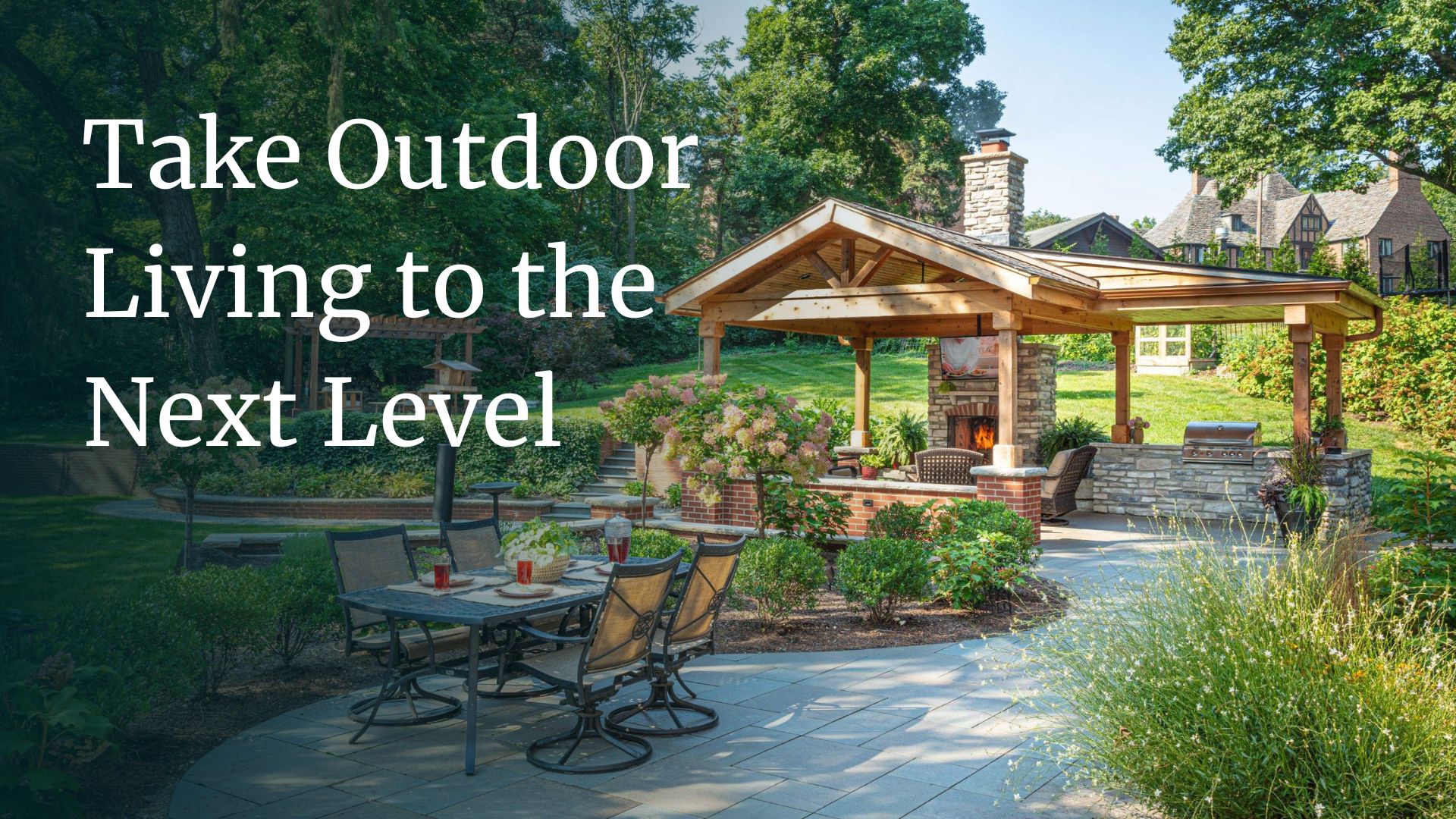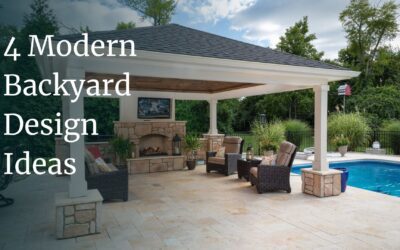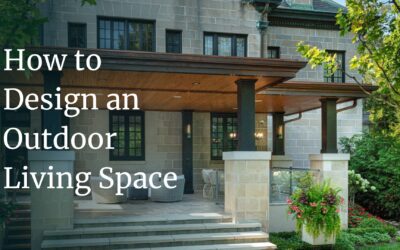With Ohio’s unpredictable weather, a covered outdoor entertainment area at home is not just a nicety; it’s a necessity. From pavilions to pergolas to porches, let’s take a look at designing the perfect spot to enjoy the outdoors no matter what Mother Nature dishes out.
Before you can pull up your lounge chair or dig in to that perfectly grilled dinner al fresco, you’ll need to make some important design decisions.
Attached or Freestanding?
One of your first decisions is to determine whether your covered outdoor entertainment area will be attached to your house (or another structure like a garage) or stand on its own.
The roof structure for a covered porch, deck or patio is typically tied to the structure of a house. This kind of covered area is perfect if you want complete shade and coverage from rain that’s easily accessible from indoors. When it’s time to host a dinner party, relax with a book or enjoy a morning cup of coffee, you can just step outside.
You can get the same protection from rain and hot sun out in your yard with a freestanding pavilion or gazebo. These structures can be a focal point in your garden or a welcome seating area near a pool or cornhole court.
No matter where your covered area is, adding screens to the structure can provide some relief from pesky insects or give your indoor pets a safe place to feel a breeze. Retractable units that can be installed along the roof edge offer you the flexibility of having screens or not.
Throwing Shade
Maybe you’d like a covered outdoor entertainment area that offers a bit of shade, but still allows for natural light. A pergola topped with slats or beams is a good choice. Growing vines or plants up and over the structure increases the shade coverage in the summer, while allowing for more sunlight and warmth under the structure when the plants die back in the winter.
Retractable awnings or shade sails are another way to give your outdoor living space flexibility. Adjust the coverings as needed or move them away when you want to feel the sun or gaze at the stars.
On the Inside
Now that you have the location of your outdoor area and the structure of its roof decided, it’s time to think about what elements you’d like to include in your entertainment area. With so many creature comforts now designed for outdoor living, the sky is practically the limit.
Comfortable Seating Areas
One of the first things that comes to mind when entertaining outdoors is having space for furnishings where friends and families can gather to relax. To create an outdoor living room, leave enough space for outdoor groupings like sectionals, love seats or lounge chairs. If you enjoy afternoon siestas, consider making space for a chaise or two.
Consider the size and layout of your lounge furniture as you design your outdoor living space. Remember to plan for side tables or ottomans. Leave room for foot traffic to move around big pieces of furniture.
Welcoming Dining Spaces
Is there anything better than eating outside when the weather is good? (Or under a sheltering roof if rain is in the forecast?) As you plan to entertain outdoors, think about how and where you’d like to serve food. Do you prefer casual snacks set up on a bar or something more formal at a long table with plenty of chairs? Will you need a couple of different dining spots to accommodate large crowds? Could seating walls accommodate overflow when necessary?
Again, make sure to plan plenty of space so chairs can be moved away from the tables and still allow for traffic to flow easily. Keep in mind where the dining areas will be in relation to where food is being prepared, whether that’s inside or in an outdoor kitchen.
Consider both food and drink as you plot out the “floor plan” of your outdoor area. Would you like to include an outdoor bar area? Will it have a refrigerator or wine cooler? Plan ahead for storage of glasses, pitchers and bar utensils. Think about adding containers for easy recycling of cans and bottles.
Handy Grill Islands and Kitchens
Your covered outdoor entertaining area is the perfect spot for a grill island or a complete outdoor kitchen. Depending on how you like to cook outdoors, the island can include a grill, smoker, pizza oven, flattop griddle or all of the above. Building appliances into an island or a fully equipped kitchen offers the opportunity to add counters and cabinets that work well for storage and serving. Access to water and gas lines and electric outlets will be important for your island or kitchen area.
Big Screens
With today’s outdoor televisions, your outdoor living space can be a favorite spot for hosting friends and family. Catch the big game or gather to watch a movie with the kids. If you plan to hang a screen (or two) outside, keep its location in mind as you plan for seating. You’ll also want to discuss with your designer the need for electric outlets and possible cable hookups.
Adding Heat
Really want to boost the cozy factor in your outdoor covered entertainment area? Bring in some warmth for those chilly nights or cooler days. There are plenty of options from patio heaters to outdoor fireplaces to fire tables. Keep your budget in mind and the amount of space you’ll have for your outdoor living space.
An outdoor fireplace can be fueled by wood or natural gas. Fire tables typically burn natural gas.
The Beauty of Water
The gentle sound of water can significantly enhance the atmosphere of an outdoor living space. Your options for water features include:
- Tabletop fountains: Small, self-contained fountains are perfect for covered patios or gazebos, requiring minimal space.
- Wall fountains: If you have an exterior wall adjacent to your covered area, a wall-mounted fountain can add a beautiful visual and auditory element.
- Container ponds: A large, watertight container can be transformed into a mini pond with aquatic plants and even a small pump for a bubbling effect.
Remember that any water feature in your space should be easily accessible for filling and cleaning, and consider proximity to power outlets if it’s electric.
Make Your Space Sparkle With Lighting
The right lighting for your outdoor entertainment area makes a big impact. Today’s smart outdoor lighting systems can be controlled via an app, allowing for dimming, color changes and scheduling.
If your outdoor area is not attached to your house, talk with your designer about running wiring to standalone structures.
Consider adding three layers of lighting:
- Ambient
- Task
- Accent
Ambient or Overall Lighting
This layer of light creates general lighting throughout the space and often comes from fixtures mounted on the ceiling. Places to add ambient lighting include over dining areas, furniture groupings or outdoor kitchens. String lights that span the space add both charm and general illumination. You can also add floor or table lamps in outdoor seating areas. Always look for fixtures that are rated for outdoor use.
Task Lighting
As the name implies, task lighting helps you perform certain activities. You’ll want task lighting for your grill island or outdoor kitchen so you can see to prep and cook after dark. For reading or card games, an outdoor table lamp or floor lamp will be helpful.
Accent Lighting
Don’t overlook these small but difference-making fixtures. Highlight a piece of garden art or an especially beautiful tree or shrub planted near your outdoor living area. If you have stairs in the area, placing small lights under each step helps people move around the yard safely at night. The same is true for path lights, especially if your entertaining area is located away from your house.
Tie Everything Together With Landscaping
As you plan your project, you’ll work with a landscape designer to anchor your new covered outdoor entertainment area to its site with plantings. Keep in mind that any containers or plants planted near the structure may have less direct sun, airflow and rainfall. Your landscape designer will help you choose and install plantings that will thrive in those conditions. For instance, they might choose shade-loving plants that prefer not to be in full sun, such as ferns and hostas.
A covered outdoor area can offer the perfect place for hanging baskets or climbing plants. Pergolas, in particular, create structure for vines and climbers like wisteria, clematis, trumpet vine, climbing roses or grapevines for a Mediterranean feel.
If your outdoor area is located in full view of the neighbors, you might add plantings for privacy to your landscape plan. If your area includes a wall, a vertical garden can add lush greenery, herbs or flowers without taking up floor space. You can get a similar effect with trellises.
The Role of Hardscaping
As you design your outdoor entertainment space, you’ll discuss your options for hardscaping materials like pavers, stone and wood decking. Each has its pros and cons, so take the time to choose based on your style and maintenance preferences.
Edging materials including stone, brick or metal, can be used to define planting beds around the covered area. For areas where plants won’t thrive due to deep shade, decorative gravel or river pebbles can provide a clean, low-maintenance groundcover. Consider creating inviting pathways leading to and from the covered area with stepping stones.
Start Your Covered Outdoor Entertainment Area
Ready to create your own magical living space outside? Contact us to start the conversation.




